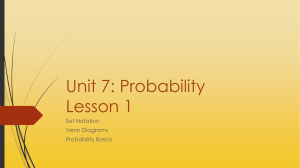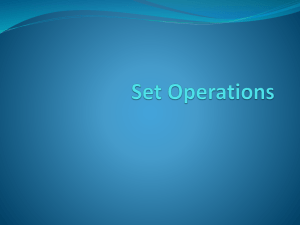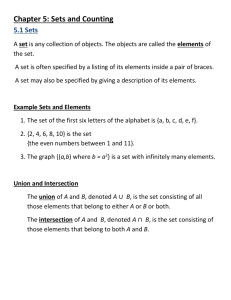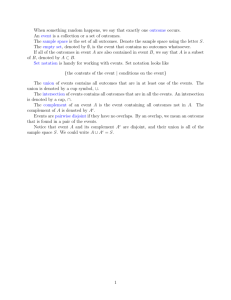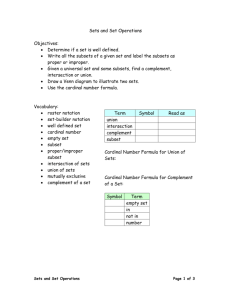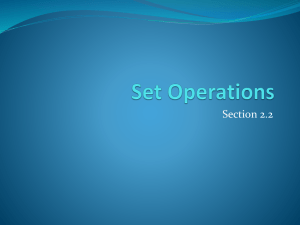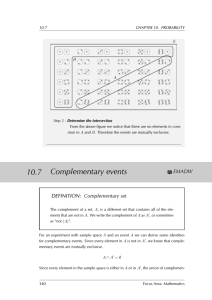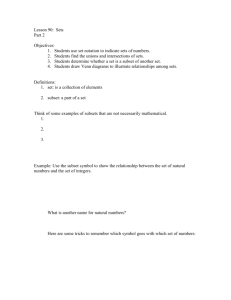Document
advertisement
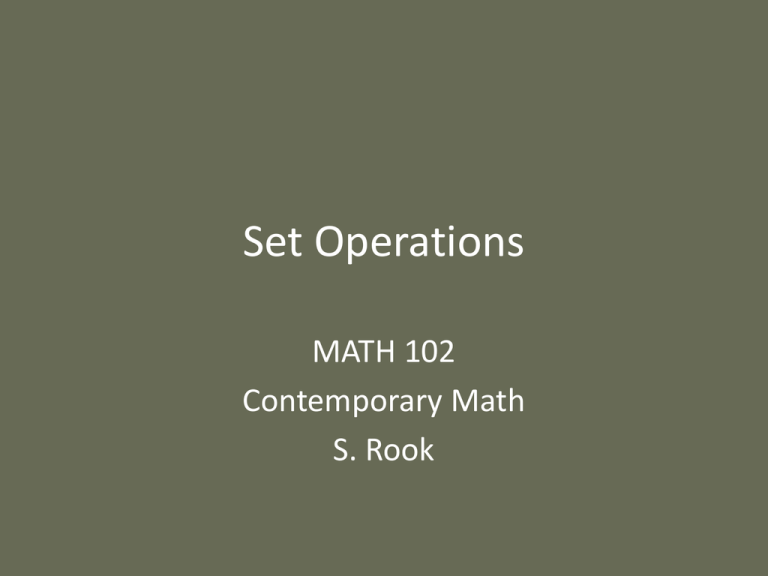
Set Operations
MATH 102
Contemporary Math
S. Rook
Overview
• Section 2.3 in the textbook:
– Intersection & Union
– Complement
– Difference
Intersection & Union
Intersection of Sets
• Given sets A and B, the intersection of A and
B, denoted A B , means to list those
elements common to both sets
– Only those elements present in BOTH A and B are
part of the intersection
– e.g. Let A = {1, 2, 3, 4, 5} and B = {2, 4, 6, 8}. Find
A B
– Can also represent using a Venn Diagram
Union of Sets
• Given sets A and B, the union of A and B,
denoted A B , means to combine the
elements of A and B together
– i.e. fill an initially empty set (bag) with the
elements of A and then the elements of B
– An element present in BOTH A and B is only added
once to the union
– e.g. Let A = {1, 2, 3, 4, 5} and B = {2, 4, 6, 8}. Find
AUB
– Can also represent using a Venn Diagram
Union of Sets (Continued)
• Given sets A and B, what is the relationship
between n(A), n(B), and n(A U B)?
– e.g. Let A = {p| p is a person sitting in the front
row} and B = {g | g is a person wearing glasses}.
What are the values of n(A) and n(B)?
• What is the value of n(A U B)?
• Why does the sum of n(A) and n(B) not equal n(A U B)?
n A B n( A) n( B) n A B
– Verify for yourself that the value of n(A U B)
checks for sets A and B on the previous slide
Intersection & Union (Example)
Ex 1: Let A = {2, 3, 4, 5, 7, 9}, B = {x | x is an
even natural number}, and C = {y | y is an odd
natural number} . Find the following sets:
a) A B
b) B C
c) B C
Complement
Complement
• Universal set: the set of all elements being
considered in a problem. Often denoted by U.
– All subsets in a problem are taken from the universal set
• Given set A, the complement of A, denoted by A’,
means to list those elements that A is missing from
the universal set
– i.e. those elements that need to be added to A to
complete the universal set
– e.g. Let U = {1, 2, 3, … , 10} and A = {1, 6, 9, 10}. Find A’.
– Can also represent using a Venn Diagram
Complement (Example)
Ex 2: Let U = {a, b, c, d, e, f, g, h},
A = {a, b, c, e, g}, B = {a, b, c, d, e, f, g, h}, and
C = { }. Find:
a) A’
b) B’
c) C’
Difference
Difference
• Given sets A and B, the difference of A and B,
denoted A – B, means the resulting set when
the elements of B are removed from the
elements of A
– i.e. Just like subtraction, we are taking away those
elements in B away from A
– e.g. Let A = {1, 2, 3, 4, 5, 6} and B = {2, 3, 4}. Find
A – B.
– Can also represent using a Venn Diagram
Difference (Example)
Ex 3: Let U = {1, 2, 3, … }, A = {1, 3, 5, 7, 9, … },
B = {1, 2, 3, 4, 5, 6, 8}, and C = {2, 4, 6, 8}. Find
the resulting set:
a) B – C
b) C – B
c) A – C
Combining Set Operations (Example)
Ex 4: Let U = {1, 2, 3, …, 10 }, A = {1, 3, 5, 7, 9},
B = {1, 2, 3, 4, 5, 6}, and C = {2, 4, 6, 7, 8}. Find
the resulting set:
a) A 'B C '
b) A B C ' '
Combining Set Operations (Example)
Ex 5: Shade the appropriate regions in a Venn
Diagram to represent the resulting set:
a) A B C
b) A C B C '
Summary
• After studying these slides, you should know how
to do the following:
–
–
–
–
–
Find the intersection and union of sets
Calculate the number of elements in the union of sets
Find the complement and difference of sets
Apply multiple set operations
Use Venn Diagrams to illustrate set operations
• Additional Practice:
– See the list of suggested problems for 2.3
• Next Lesson:
– Survey Problems (Section 2.4)

